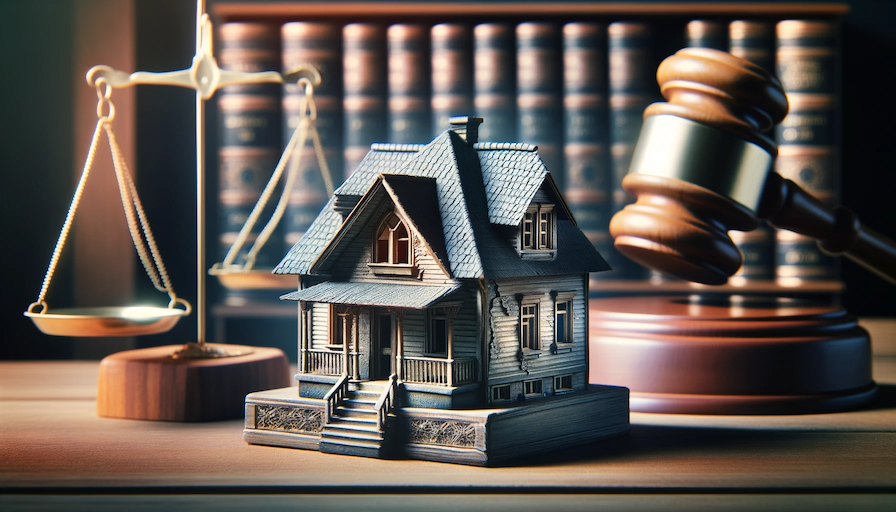What is a Foreclosure?
Foreclosure is a legal process that allows lenders to recover the amount owed on a defaulted loan by taking ownership of and selling the mortgaged property.
This process is triggered when a borrower fails to uphold the terms of the mortgage document, typically by missing a specific number of monthly payments.
The legal basis of foreclosure derives from a mortgage or deed of trust contract, which gives the lender the right to use a property as collateral in case the borrower fails to meet the terms of the mortgage document.
The Foreclosure Process
Foreclosure is a legal process that lenders use to reclaim a property due to the borrower’s failure to make mortgage payments. Understanding the steps involved in foreclosure can help homeowners recognize their options and rights throughout the process.
- Missed Payments and Notices: Foreclosure typically starts after a borrower misses at least one mortgage payment. The lender sends a missed-payment notice, followed by a demand letter after two missed payments, indicating the seriousness of the situation.
- Notice of Default: If the borrower continues to miss payments for 90 days, the lender issues a notice of default. This document is often recorded with the county to make the foreclosure public. At this stage, the loan is transferred to the lender’s foreclosure department.
- Reinstatement Period: After the notice of default, the borrower enters the reinstatement period, usually lasting about 30 days. During this time, the borrower can pay the overdue amounts and reinstate the loan, thus stopping the foreclosure process.
- Foreclosure Action: If the borrower fails to resolve the default, the lender may move forward with the foreclosure. Depending on the state, this can be a judicial foreclosure, requiring court proceedings, or a nonjudicial foreclosure, handled outside of court.
- Sale of the Property: In a foreclosure, the property is typically sold at a public auction. The highest bidder can purchase the property, with the proceeds going to pay off the mortgage and any legal costs.
- Eviction: After the sale, if the former homeowner does not voluntarily leave the property, they can be evicted. This process is conducted through a court order.
- Deficiency Judgment: If the sale of the property doesn’t cover the mortgage balance and legal costs, the lender may seek a deficiency judgment against the borrower for the remaining amount.
- Right of Redemption: In some states, borrowers have a “right of redemption,” which allows them to reclaim their property by paying the full amount owed, plus fees, within a specific period after the foreclosure.
Each foreclosure case can vary depending on the state laws, the lender’s policies, and the borrower’s specific situation. It’s important for homeowners facing foreclosure to seek legal advice to understand their rights and options fully.
Consequences of Foreclosure
Foreclosure can have significant consequences, both financially and emotionally.
- Credit Score Damage: Foreclosure severely impacts the borrower’s credit score. It remains on the credit report for seven years from the date of the first missed payment, making it challenging to obtain new credit or loans. This long-term negative mark can lead to higher interest rates and less favorable loan terms in the future.
- Emotional and Psychological Stress: Losing a home to foreclosure is often an emotionally devastating experience. It can lead to feelings of embarrassment, stress, and a sense of instability. For families, this impact is magnified, especially if it involves uprooting children and disrupting their schooling and social life.
- Difficulty in Obtaining Future Housing: Post-foreclosure, finding new housing can be challenging. Many landlords conduct credit checks and may be hesitant to rent to someone with a foreclosure on their record. This situation can lead to limited housing options or the necessity to pay higher deposits.
- Potential Deficiency Judgments: If the foreclosed property is sold for less than the amount owed, the lender may pursue a deficiency judgment against the borrower for the remaining balance. This can lead to additional financial strain as borrowers are required to pay the difference.
- Impact on Employment Opportunities: Some employers conduct credit checks as part of their hiring process. A foreclosure on the credit report can be a red flag, potentially affecting job prospects, especially in finance-related or government sectors.
- Tax Implications: Depending on the state and the specific circumstances, borrowers may face tax implications. If the lender forgives any part of the mortgage debt, that forgiven amount might be considered taxable income.
- Loss of Home Equity: Foreclosure means losing any equity built up in the home. This loss is a significant financial setback, especially for those who have invested years in paying their mortgage, as it erodes the asset base that could have been used for future financial needs or retirement.
- Long-Term Financial Planning Disruption: Foreclosure can disrupt long-term financial plans. Homeownership is often a critical component of personal financial strategies, and losing a home can mean a substantial setback in financial goals and retirement planning.
Alternatives to Foreclosure
Fortunately, there are alternatives to foreclosure that can help homeowners stay in their homes or at least mitigate the negative impacts of foreclosure.
- Loan Modification: Homeowners can negotiate with their lender to modify the terms of their mortgage. This could involve reducing the interest rate, extending the loan term, or even reducing the principal amount owed. Loan modifications aim to make the monthly payments more affordable.
- Refinancing: If a homeowner has enough equity in their property and a good credit score, refinancing the mortgage could be a viable option. This involves taking out a new loan with better terms to pay off the existing mortgage, potentially leading to lower monthly payments.
- Forbearance Agreement: In some situations, lenders may agree to a forbearance plan, temporarily reducing or suspending mortgage payments for a short period. This is often offered during temporary financial hardships with the understanding that the homeowner will resume regular payments plus an additional amount to catch up.
- Short Sale: If the home’s value has decreased below the mortgage amount, a short sale might be an option. This involves selling the home for less than the mortgage balance with the lender’s approval. While this doesn’t save the home, it can mitigate credit damage compared to a foreclosure.
- Deed in Lieu of Foreclosure: Homeowners can voluntarily transfer the property title back to the lender instead of going through foreclosure. This can minimize the negative impact on credit scores and offer a more graceful exit from the property.
- Bankruptcy: As a last resort, filing for bankruptcy might stop the foreclosure process temporarily. Bankruptcy can provide time to reorganize debts, but it has significant long-term impacts on credit and financial status.
- Government Assistance Programs: Programs like the Home Affordable Modification Program (HAMP) and the Home Affordable Refinance Program (HARP) can provide assistance to eligible homeowners. These programs are designed to help those struggling with their mortgage payments to avoid foreclosure.
How to Stop Foreclosure
Foreclosure is a serious matter that can have long-lasting effects on your financial health. However, there are several strategies you can employ to halt this process:
Communicate with Your Lender: The first step in avoiding foreclosure is to contact your lender. Lenders are often more willing to work with homeowners who are proactive about resolving their mortgage issues. They may be able to offer you a loan modification, a temporary reduction or suspension of your payments, or a repayment plan based on your current financial situation.
Apply for a Loan Modification: A loan modification changes the terms of your loan to make your payments more affordable. This could involve reducing the interest rate, extending the term of the loan, or adding missed payments to the loan balance. A loan modification can also involve switching from an adjustable-rate mortgage to a fixed-rate mortgage.
File for Bankruptcy: Bankruptcy can stop foreclosure in its tracks. Once you file for bankruptcy, an “automatic stay” is put into place, which bars your lender from continuing with the foreclosure process. This is a significant step, and it’s important to consider the consequences, including the impact on your credit score.
Consider a Short Sale: If your home is worth less than the amount you owe, your lender may agree to a short sale. This involves selling your home for less than the balance remaining on your mortgage. While a short sale will still negatively impact your credit score, it’s not as damaging as a foreclosure.
Read More: How To File for Bankruptcy: 8 steps
How to save $435.00 on your loan
The price difference for a $500.00 loan in 90 days is $435.00.
Foreclosure FAQs
What Does Foreclosure Mean?
Foreclosure is a legal process that allows lenders to recover the amount owed on a defaulted loan by taking ownership of and selling the mortgaged property. Typically, default is triggered when a borrower misses a specific number of monthly payments, but it can also happen when the borrower fails to meet other terms in the mortgage document.
How To Stop Foreclosure?
There are several ways to stop a foreclosure. The simplest answer is to make any overdue payments to bring your loan current. That doesn’t mean you have to pay off your entire mortgage, just all the late payments you owe. If you can bring it to that point, the pre-foreclosure process stops, and you return to a state of simply paying your mortgage on a regular basis. Other options include applying for a loan modification, filing for bankruptcy, short selling your home, or opting for a deed-in-lieu of foreclosure.
How Long Does Foreclosure Take?
The length of the foreclosure process can vary greatly and depends on state laws, the lender, and the cooperation level of the borrower. On average, a foreclosure process can take anywhere from a few months to over a year.
How To Buy Foreclosure Homes?
Buying a foreclosed home can be a great way to get a deal on a property. However, it’s important to understand that these properties are usually sold “as-is,” meaning the lender will not make any repairs. The process typically involves bidding at a public auction, or buying the property directly from the lender as an REO. It’s recommended to work with a real estate agent experienced in foreclosures and to get a home inspection before purchasing.
How Many Missed Payments Before Foreclosure?
Typically, a lender can’t initiate foreclosure unless you’re at least 120 days behind on your mortgage payments. This period, known as pre-foreclosure, is when the lender is also required to provide “loss mitigation” options designed to help you resolve the situation with as little damage to your credit and finances as possible.
How Long Does A Foreclosure Stay On Your Credit?
A foreclosure appears on your credit report within a month or two and stays there for seven years from the date of the first missed payment. After that, the foreclosure is deleted from your credit report.



